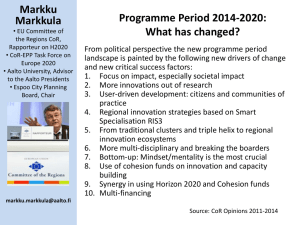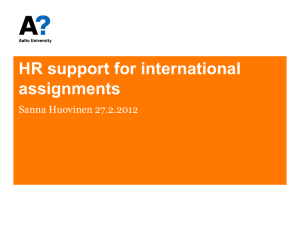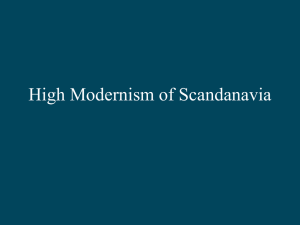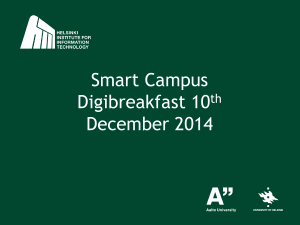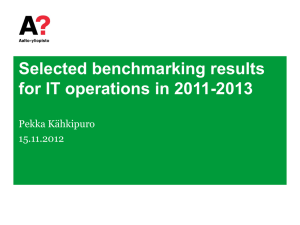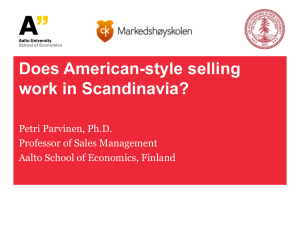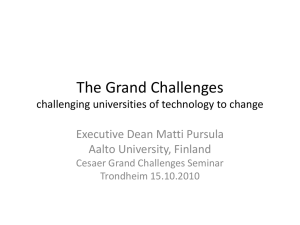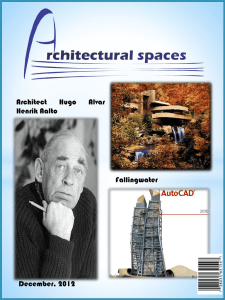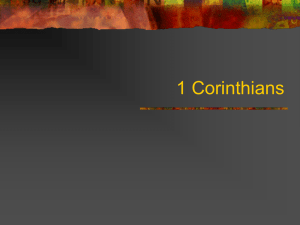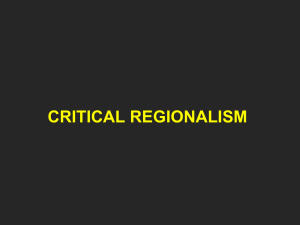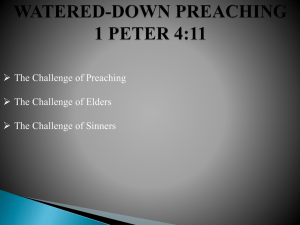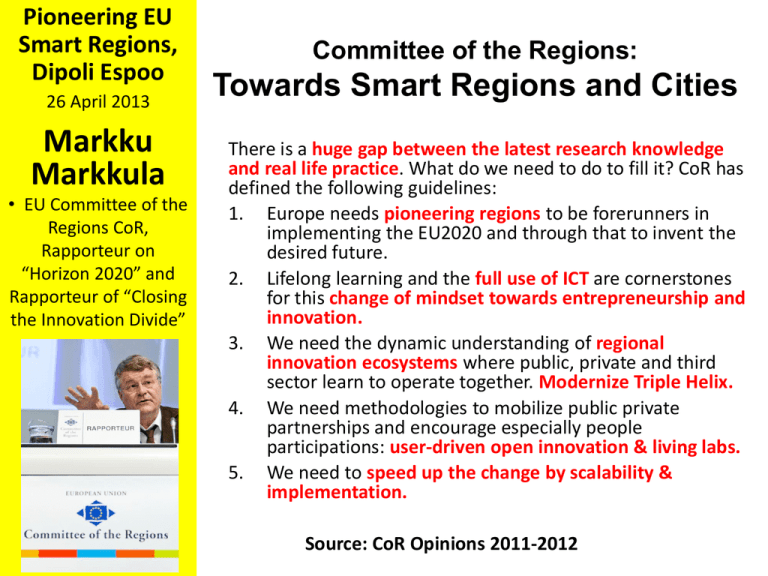
Pioneering EU
Smart Regions,
Dipoli Espoo
26 April 2013
Markku
Markkula
• EU Committee of the
Regions CoR,
Rapporteur on
“Horizon 2020” and
Rapporteur of “Closing
the Innovation Divide”
Committee of the Regions:
Towards Smart Regions and Cities
There is a huge gap between the latest research knowledge
and real life practice. What do we need to do to fill it? CoR has
defined the following guidelines:
1. Europe needs pioneering regions to be forerunners in
implementing the EU2020 and through that to invent the
desired future.
2. Lifelong learning and the full use of ICT are cornerstones
for this change of mindset towards entrepreneurship and
innovation.
3. We need the dynamic understanding of regional
innovation ecosystems where public, private and third
sector learn to operate together. Modernize Triple Helix.
4. We need methodologies to mobilize public private
partnerships and encourage especially people
participations: user-driven open innovation & living labs.
5. We need to speed up the change by scalability &
implementation.
Source: CoR Opinions 2011-2012
Nokia
Regional Innovation Ecosystem
Aalto University Campus 2020
Young entrepreneurial mindset
Rovio
Aalto
University
Tapiola
Garden
City
Laurea
EIT ICT Lab
According to the plans, by 2020, there will be new investments of 4-5 billion €:
metro, tunnel construction of ring road, other infra, housing, office and business
buildings, public services, university buildings, sports and cultural facilities…
Aalto City Integrating Real and Virtual Worlds
Aalto University campus with its surrounding business and residence areas is the innovation hub of the Helsinki
Region. This picture is based on the Energizing Urban Ecosystems research program. The program with its € 20
million multidisciplinary research integrates new science, art and business developments to working in a
virtual environment. Regional Information Modeling is the breakthrough dimension in this research.
Regional Information Modeling
Building Information Modelling (BIM) is used in controlling single
construction process in order to record physical and activity based
features in a digital form. The resulting building information models
become shared knowledge resources to support decision-making
about a facility from earliest conceptual stages, through design and
construction through its operational life and eventual demolition.
Regional Information Model can be considered as a similar presentation
of a larger area of built environment, that can be further used e.g. for
virtual city planning. Regional Information Model could be a reliable
and trustworthy basis for lifetime engineering supporting new value
adding activities and decision making.
Towards Regional Information Modeling
(CdR CdR 104/2010 fin)
“Committee of the Regions (CoR) points out that management of the
built environment and urban planning are sectors with a high impact on
the local economy as well as on the quality of the living environment.
New developments in information management can play a crucial role
in achieving the goal of establishing an ambitious new climate regime.
Building Information Modelling (BIM) is actively used in facility
management to provide a digital representation of the physical and
functional characteristics of a facility.
The concepts of BIM should be extended to regional and urban
planning. It could then serve as a shared knowledge resource for an
area, forming a reliable basis for life-cycle analysis, user-driven
business process development and value-creating decision-making.”
OPINION of the Committee of the Regions on the DIGITAL
AGENDA FOR EUROPE,
approved by the CoR Plenary on 6 October 2010
The Frame for Implementing Knowledge Triangle
(Synergy between Research, Education and Innovation)
Source: Markku Markkula, article in the Knowledge Triangle book, 2013
The Hubconcepts™ - Innovation Hub Framework
Anchors
Growth SMEs
Company and forum
driven activities
Start-ups
“Smart
Handover”
First-class master plans
&
Innovation Hub concepts
Incubation Environments
complete each other
Living Labs / Test-Beds
Public-private
partnerships
Cluster Policies & Programs
Research & Development Activities
Education (elementary to university)
Physical Infrastructure and Service Structures
Public policy
driven activities
National /Regional Innovation Policy
Residential Zone
Semiconductor Phase I
Biotech & Pharma Phase I
Technology Innovation Area
Scientific Research and
Education Zone
Semiconductor Phase II
Biotech & Pharma Phase II
Copyright and all rights reserved.
The Development Path of
the Regional Innovation Ecosystem (RIE)
Public
support
Stage 1: Creating
pre-conditions
Stage 2: Initiating
transformation
towards RIE
Stage 3: Orchestration
for global business
Development of National or Regional Innovation System
Source: Jukka Viitanen & Markku Markkula & Carlos Ripoll, article in the Knowledge Triangle book, 2013
The Development Path in More Detail
Stage 1 Regional pre-conditions:
1. Potential of existing regional/international innovation system (=audits)
2. Willingness to utilise this potential (=active participation)
Stage 2 Creating the innovation hub:
1. Joint R&D
2. Joint innovation capacity
3. Joint commercialization
4. Joint platforms
Stage 3 Orchestrating RIE:
1. Mindset change
2. Implementing Knowledge Triangle
3. Integrating innovation activities with research programs
Source: Jukka Viitanen & Markku Markkula & Carlos Ripoll, article in the Knowledge Triangle book, 2013
Mindset
Situation when Aalto started in 2010
EU Calls for Transformation:
Europe needs pioneering regions, as
pathfinders and rapid prototypes.
Helsinki Region has forerunner
instruments in use:
Aalto Design Factory
Aalto Venture Garage
Aalto Camp for Societal Innovation
and many more …
Markku Markkula
CoR & Aalto University
Have a look at:
www.aaltodesignfactory.fi
ACSI 2011: We Cannot Reach the Target by Incremental Small Steps
Today: Separate
projects and silos
Inventing the future: Working and learning together
Gardening to enable uniqueness
Fruits of global pioneering
to the use of all
The upside-down tree metaphor originates 1992 by Leif Edvinsson
We need to create “Joint Regional Innovation Ecosystems”
The picture is based on the results of the Aalto Camp for Societal Innovation 2011: Markku Markkula
Aalto Camp for Societal Innovation ACSI
Integrating Real World & Virtual World
Finnish Way to Knowledge Society:
Regional Level = The Learning City
Learning Environments
Culture of Learning
Concept of
Learning
Learning
Methods
Values, Goals
and Strategies
Innovations,
Development
Learning
Organisations
Physical Environment
Virtual Environment
Spiritual Environment
Espoo =
The Learning City
Structure of
Economic
Life
Inclusion and
Accessibility
Impowerment
of Services
KnowledgeInternational and Citizens’
Activities
Society
Resources
Preconditions of Learning
Time Variation
Infrastructure of
Lifelong Learning
Cooperation
Between Providers of
Education
Learning Facilities and
Supportive Measures
Learning Services
This picture was done already close to 20 years ago:
This Has Been and Still Is a Long Process
Learning Environments
Culture of Learning
Concept of
Learning
Values, Goals
and Strategies
Innovations,
Development
Learning
Methods
Learning
Organisations
Structure of
Economic Life
Accessibility
of Services
Physical Environment
Virtual Environment
Espoo & European Year of
Lifelong Learning 1996
Espoo =
The Learning City
Inclusion and
Impowerment
KnowledgeInternational and Citizens’
Activities
Society
Resources
Preconditions of Learning
Spiritual Environment
Time Variation
Infrastructure of
Lifelong Learning
Cooperation Between
Providers of Education
Learning Facilities and
Supportive Measures
Learning Services
We need real life feedback indicators bench-learning
www.elli.org
UNESCO‘s four learning
dimensions
ELLI-Studies &
Publications
ELLI – Learning Community
Report
Regional
ELLI-Index
ELLI-Index
Europe
ELLI- Internet Platform
CoR Presentation by Markkula on 21 Feb 2011:
This ELLI is excellent material and instruments.
This can lead to a real societal innovation.
Horizon 2020 Frame for Research and Innovation:
How to Speed up and Scale up EU 2020 Implementation
More
Societal
Innovations
Digitalized Real Life
Test-beds
SMART
Regional
Innovation
Ecosystems
Pioneering
EU2020
Urban
Design
Solutions
Open Innovation &
Digital Entrepreneurship
SPECIALISATION
Scientific Excellence & Industrial Leadership
Markku Markkula, markku.markkula@aalto.fi
Chair CoR-EPP Task Force on Europe 2020, Aalto University, Finland
Transformation: the levers for the 3 types on innovation
(In the past: the focus on innovations has been on business and technology.
Now: also the cultural levers are the drivers of change)
Business Model Levers
Value
Value
Proposition Chain
Target
Customer
Technology Levers
Product
Process
and Service Technology
Enabling
Technology
Cultural
Levers
Regional
Innovation
Ecosystem
Space
(Ba & Flow)
Design
Incremental innovations
Semi-radical innovations
Radical innovations
Mindset
Learning
Markkula M & Pirttivaara M, (2013). Adding the Cultural Levers. Developed from Davila T,
Epstein MJ and Shelton RD, (2013), Making Innovation Work, FT Press, New Jersey.
Applying Experiences from Industrial Systems
Interacting Learning & Research & Innovation Activities
Three Steps to Understand the System:
Identify
Societal / Market Needs
& define system
requirements & barriers
Integrate Fundamental
Research & Innovation
Knowledge into
Enabling Technologies
Develop Useful Insights from
Fundamental Knowledge
Professor Sir Mike Gregory, 13 Feb 2013
(E O’Sullivan: Adapted from NSF ERC Strategy Framework)
Globalisation Need for Smart Specialisation
Understanding the dynamics of global industries
•
•
•
•
Mapping and managing global value chains
Configuring production and supply
Understanding national industrial policies
‘Making the right things in the right places’
Professor Sir Mike Gregory, 13 Feb 2013
Aalto University & other researchers & industry & cities:
Energizing Urban Ecosystems
20 million euro research program for 2012 -2015
Regional Information Modeling
in Urban Planning for the Built Environment
1. Scientific breakthroughs
2. Application breakthroughs
3. Breakthrough in mindsets
4. Breakthroughs in art & design
5. Breakthroughs in business models
This ppt-set (short version of the set made for EUE in August 2012)
gives an evidence that the real life breakthrough can be made.
Overview of the workspace used
in the EU Open Days 10A16
Workshop In Brussels Oct 10 2012
Participants produced inputs which
were uploaded to the Virtual
Environment and further developed
by the facilitators for voting.
All this happened during the
workshop.
2012
Juho-Pekka Virtanen, Tommi Hollström, Lars Miikki, Markku Markkula
Based on research on Regional Information Modelling by:
Juho-Pekka Virtanen, Hannu Hyyppä, Marika Ahlavuo, Juha Hyyppä
CoR Draft Opinion on “Closing the Innovation Divide”
Making the Transformation to Happen
1. Addressing new innovative solutions on major societal
challenges at regional level
2. Smart specialisation – what does that mean in practice
3. Smart cities and smart regions – concepts and
implementation
4. Regional innovation ecosystems as laboratories for
entrepreneurial discovery
5. Synergistic cooperation (= Knowledge Triangle & European
Partnerships) during the new programming period 20142020

